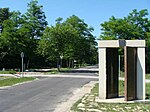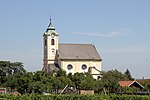The Pan-European Picnic (German: Paneuropäisches Picknick; Hungarian: páneurópai piknik; Slovak: Paneurópsky piknik) was a peace demonstration held on the Austrian-Hungarian border near Sopron, Hungary on 19 August 1989. The opening of the border gate between Austria and Hungary at the Pan-European Picnic turned out to be another initiative of a widely building peaceful chain reaction, at the end of which Germany reunified, the Iron Curtain fell apart, and the Eastern Bloc disintegrated. The communist governments and the Warsaw Pact subsequently dissolved, ending the Cold War. As a result, this dissolution also led to the disintegration of the Soviet Union.The idea of opening the border at a ceremony and testing the Soviet Union's response came from Otto von Habsburg, then the President of the Paneuropean Union, and was brought up by him to Miklós Németh, then the Hungarian Prime Minister, who also promoted the idea.The Pan-European Picnic itself developed from a meeting between Otto von Habsburg and Ferenc Mészáros of the Hungarian Democratic Forum (MDF) in June 1989. The local organisation in Sopron took over the Hungarian Democratic Forum, and the other contacts were made via Habsburg and the Hungarian Minister of State Imre Pozsgay. The Austrian Paneuropean Union and the MDF took care of advertising the event with leaflets that were distributed in Hungary. The patrons of the picnic, Habsburg and Pozsgay, who were not present at the event, saw the planned event as an opportunity to test Mikhail Gorbachev's reaction to an opening of the border on the Iron Curtain.The official emblem of the picnic was a pigeon breaking through the barbed wire. At the picnic several hundred East German citizens overran the old wooden gate, reaching Austria unhindered by the border guards around Árpád Bella. It was the largest mass exodus since the Berlin Wall was built in 1961. The Hungarian borders were opened on 11 September, and the Berlin Wall fell on 9 November. The Warsaw Pact disintegrated in 1991.












